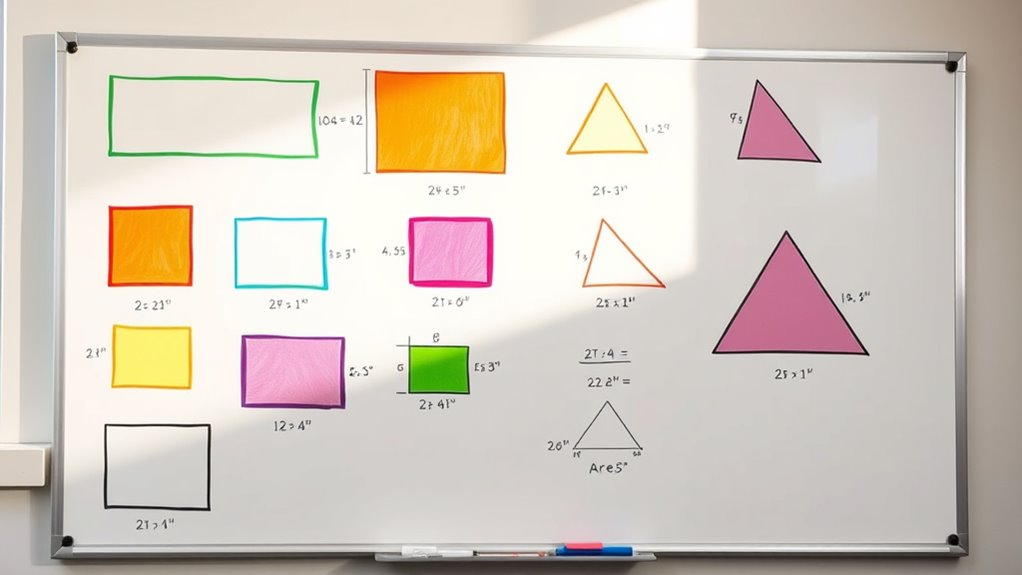To never forget easy formulas for area and perimeter, focus on simple, memorable rules. For rectangles and squares, use length × width for area and 2(length + width) for perimeter. Triangles need ½ base × height for area, while trapezoids use ½ (base₁ + base₂) × height. For irregular shapes, the shoelace formula simplifies calculations. Keep these straightforward methods in mind, and you’ll find yourself solving shape problems confidently—discover more helpful tips as you continue.
Key Takeaways
- Use the coordinate geometry distance formula to quickly find side lengths for perimeter calculations.
- Divide complex shapes into simple ones and sum their areas for easier total area computation.
- Apply the shoelace formula for irregular or composite shapes to efficiently determine area.
- Remember basic formulas: rectangle (length × width), triangle (½ base × height), trapezoid (½ (base₁ + base₂) × height).
- Mastering these formulas and methods streamlines shape calculations, reducing errors and saving time.

Are you looking for simple ways to find the area and perimeter of common shapes? If so, understanding coordinate geometry is a powerful tool that can make your calculations much easier, especially when dealing with complex figures like composite shapes. Coordinate geometry allows you to analyze shapes by plotting their points on a grid. By knowing the coordinates of each vertex, you can apply straightforward formulas to determine distances and areas without the tedious process of measuring each side manually. This approach is especially helpful when working with composite shapes—figures made up of multiple simple shapes combined together. Instead of trying to find the area or perimeter of the entire complex shape at once, you can break it down into smaller, more manageable parts, calculate each part separately, and then add or subtract as needed.
Using coordinate geometry simplifies calculating areas and perimeters of complex and composite shapes.
To find the perimeter of a composite shape using coordinate geometry, start by identifying the coordinates of each vertex. Once you have those, use the distance formula, which is fundamentally the Pythagorean theorem, to find the length of each side:
[ text{Distance} = sqrt{(x_2 – x_1)^2 + (y_2 – y_1)^2} ]This method allows you to find the length of any side, regardless of the shape’s complexity. After calculating all the side lengths, sum them up to get the total perimeter. This process is quick and precise, especially when the shape isn’t a simple rectangle or square.
Finding the area of composite shapes with coordinate geometry involves splitting the shape into simpler parts—like triangles, rectangles, or trapezoids—that you can easily calculate. Once you’ve divided the shape, use the appropriate area formulas for each component:
- For rectangles and squares: length times width
- For triangles: ½ base times height
- For trapezoids: ½ (base1 + base2) times height
Alternatively, you can use the shoelace formula (also known as Gauss’s area formula) when you have all the vertices plotted. By plugging the coordinates into this formula, you can quickly find the total area of the entire shape, even if it’s complex. This method is especially useful for irregular or highly composite shapes, as it simplifies the calculation without needing to decompose the shape manually.
Mastering these coordinate geometry techniques saves you time and reduces errors when calculating areas and perimeters. They’re invaluable skills for tackling real-world problems involving complex shapes, whether in school, engineering, or design. With practice, you’ll find that breaking down composite shapes and applying these formulas becomes second nature, making geometry much less intimidating and much more manageable.
Frequently Asked Questions
How Do I Find the Area of Irregular Shapes?
To find the area of irregular shapes, you can break them down into simpler shapes like triangles and rectangles through polygon decomposition. Once you’ve divided the irregular polygon into regular parts, calculate each area individually using basic formulas. Then, add all these areas together for the total. This method makes working with irregular polygons easier, allowing you to find their area accurately without complex formulas.
Can Formulas Be Used for Three-Dimensional Objects?
When working with three-dimensional objects, formulas help you find 3D volume calculations and cross-sectional areas. You calculate volume by multiplying length, width, and height, while cross sections reveal slices of the shape. Although 2D formulas aren’t directly used for 3D objects, understanding these concepts helps you determine the space inside, making 3D math more manageable and meaningful.
What Are Common Mistakes in Calculating Perimeter?
When calculating perimeter, common misconceptions include forgetting to add all sides or confusing perimeter with area. Many make calculation errors by double-counting sides or ignoring irregular shapes. To avoid mistakes, double-check each side length, especially in complex figures, and confirm you’re summing all sides accurately. Remember, perimeter is the total distance around a shape, so thoroughness prevents common calculation errors.
How Do I Convert Units in Area and Perimeter Calculations?
Imagine swapping shoes to match the size of your feet. To convert units in area and perimeter calculations, you need to modify measurement units, just like changing shoes. Find the conversion factor between your current units and the desired units. Multiply your measurement by this factor. Whether you’re switching from inches to centimeters or feet to meters, this ensures your calculations stay accurate across different measurement units.
Are There Shortcuts for Complex Shapes?
When tackling complex shapes, you can use shape segmentation to break them into simpler parts, making calculations easier. Shortcut estimation helps you approximate area or perimeter quickly without precise measurements. By dividing a complex shape into rectangles, triangles, or circles, you streamline your work and avoid complicated formulas. This approach saves time and improves accuracy, especially when exact measurements aren’t necessary.
Conclusion
Now, with these simple formulas, you hold the key to unveiling endless shapes around you. Picture yourself walking through a park, each step revealing rectangles, circles, and squares, all easily measured with your newfound knowledge. No more confusion or frustration—just confidence and clarity in your hands. Remember, every shape tells a story, and now, you’re the one who can understand and appreciate its beauty. Keep practicing, and let your curiosity turn into mastery.









